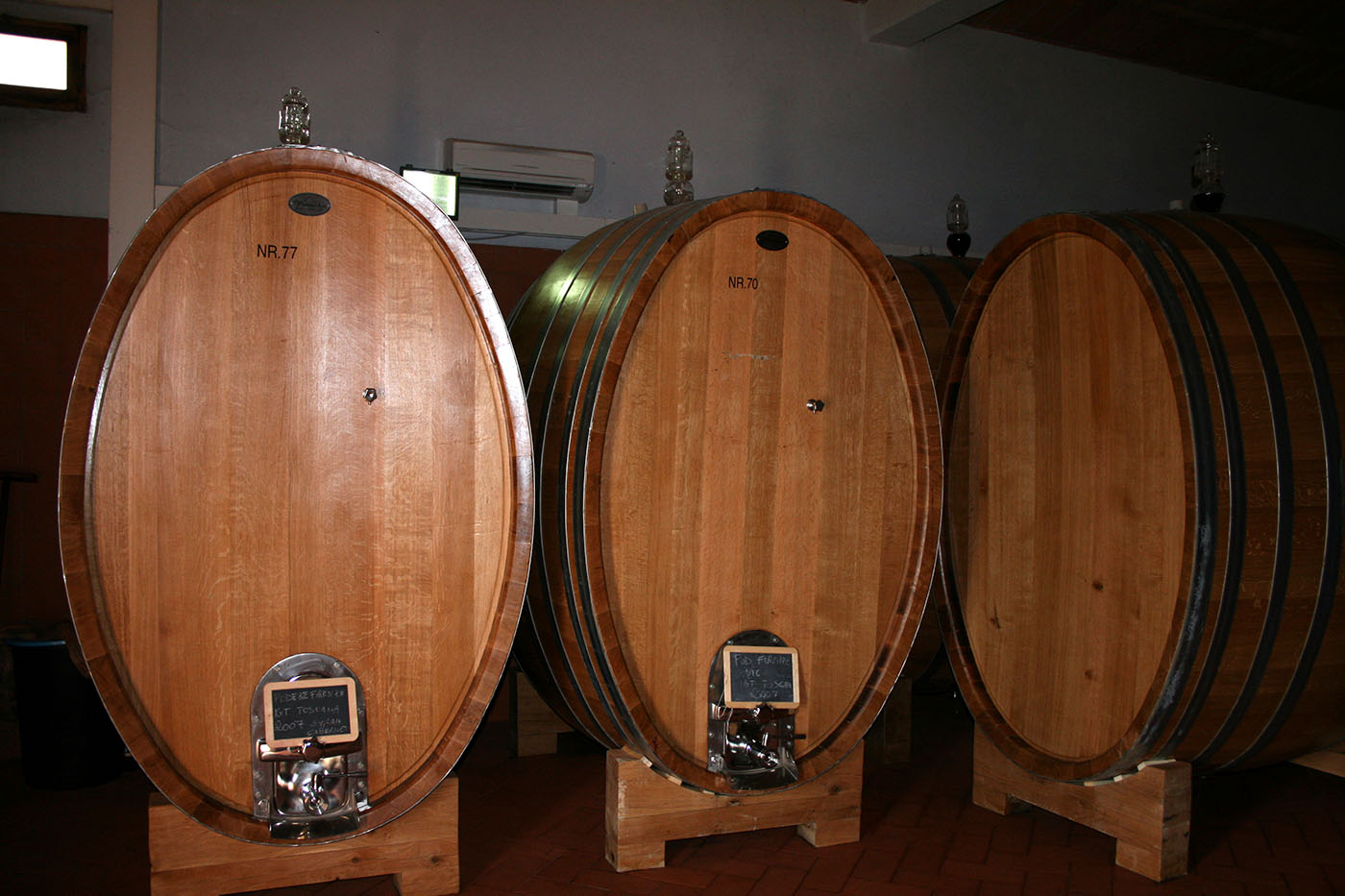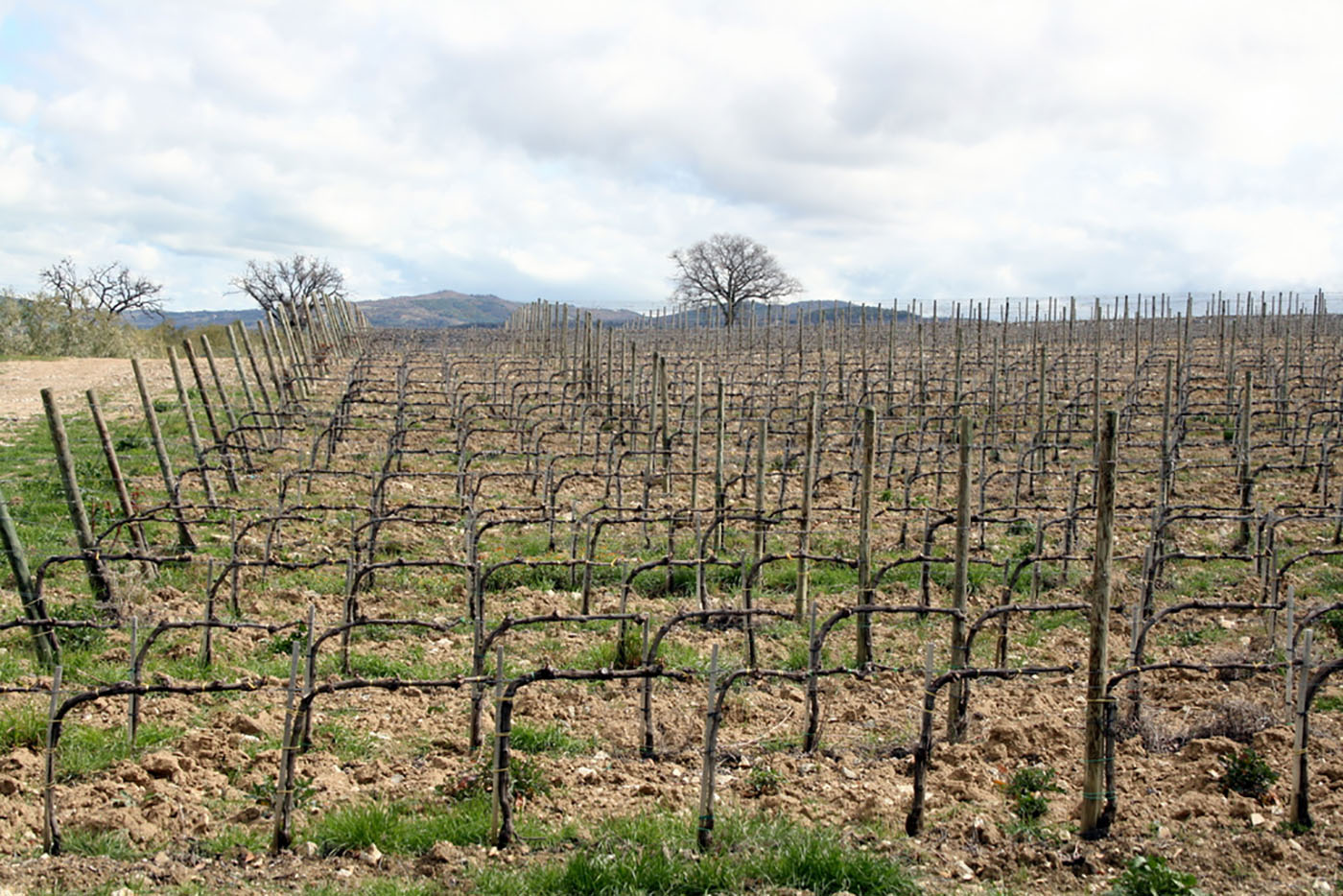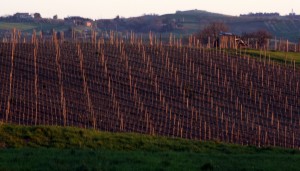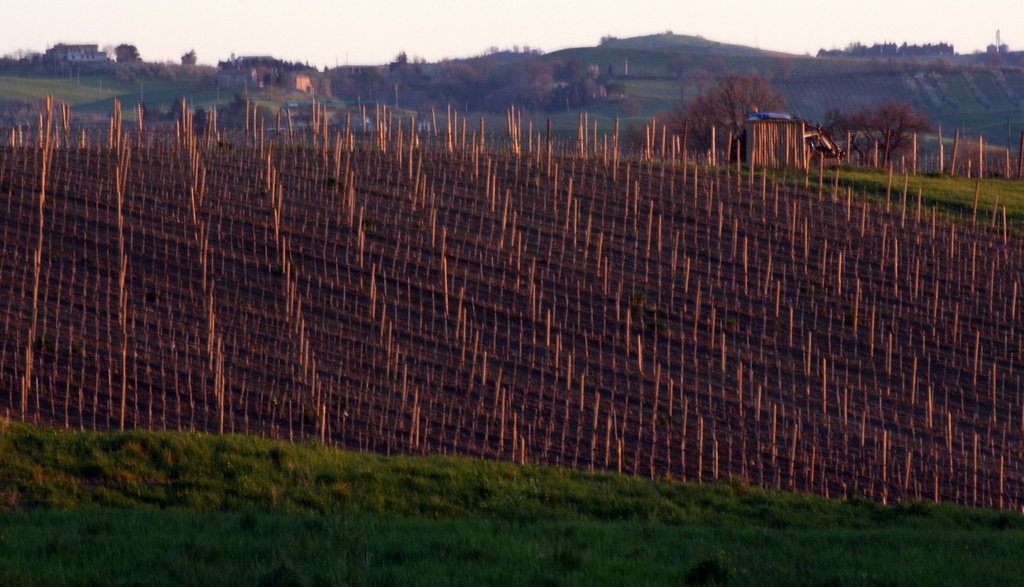Montecucco
The lower part of the northern Maremma is made up of two quality wine areas, ie two DOCs. Starting inland again, there is Montecucco, which is the roughly L-shaped area South West of the Montalcino plateau. It is further inland than the even less well known Montereggio di Massa Marittima (see next section). Neither has a long history of quality wine production and both have struggled to gain recognition. They may well both disappear from labels if the new EU-inspired larger areas (in this case DOP Maremma) take off. In this section, we will focus on Montecucco, overwhelmingly a red wine area.

Links to featured wineries:
- Salustri – pride of Montecucco
- Le Vigne – one very large vineyard!
- Trottolo – Dario’s kingdom
- Perazzetta – regional player
- Parmoleto – developing quality
- All wines tasted in spring 2007 unless stated otherwise.
Salustri – pride of Montecucco
A perennial problem of visiting wineries around Easter is the confluence of the brief holiday itself and then Vinitaly, the five-day, mammoth, annual wine fair at Verona. Leading producers are either preparing for, at or recovering from Vinitaly. Our visit to Salustri was somewhat curtailed by the V factor but it was still well worth going to this leading organically run farm and winery in the Montecucco area. Although the site is not big, Salustri is a regional player, producing its own quality wines and making and storing wine for others. Unusually it also keeps examples of its own bottles for ageing and has very beautiful labels.
At the winery we tasted just the quality red, Marleo 2006: made of 90% Sangiovese and 10% Ciliegiolo:

it had a good ruby colour with a pronounced purple rim (March 2007), a moderate cherry nose which opened up with time, good dense fruit and decent balancing astringency. Even in a red wine area this is as good a basic quality red as you will find. In 2008 we did taste one of the older bottles, Marleo again but this from 2002. It still had lots of lovely cherry fruit but now with leather notes, and some refinement on the palate, good acidity and fine tannins. Very good/excellent. Salustri also make a white (Narà, 100% Vermentino) and two top reds, Santa Marta (from 30 years old vines, oak aged for 18 months) and Grotte Rosse (50 year old vines, slow vinification, 18 months in oak). Richard Baudains comments on the 2004 Grotte Rosse: ‘Ripe, supple Sangiovese with elegant fruit aromas, lovely balance. Deliciously natural quality on the palate. Outstanding. [Drink] 2008-15’ (Decanter August 2008)
Le Vigne – one very large vineyard
This winery, ‘the vineyards’ in Italian, is unusual in that it has most of its vines in one large vineyard, with fossil rich soil, good exposition and very good day/night temperature difference which contributes to freshness in the wine. The family have decided to stop expanding the vineyards, now at 9 hectares, because they want to manage directly what they produce. The emphasis is on gentle handling: the harvest is by hand using small panniers, they have a Teflon de-stemmer and go in for cool temperature maceration of up to three weeks.

Trottolo – Dario’s kingdom
Dario Pasqui runs a small (3 hectare) estate outside Montenero, with great views across the undulating landscape. He loves the outdoor life, for him and his young family. The wines are aged in a mixture of barriques and the rather larger tonneaux. Apart from tips on winemaking (he’s keen on inert gas when processing wines to stop oxidization), we also get a lesson in productivity of varieties: his Sangiovese produces 1.5 kg per plant, a medium yield (1kg per plant is low), while his Cabernet will produce 4 kg each!
Trottolo has three reds to taste: Monteflaminio (a sort of Super Monteccucan blend of 60% Sangiovese, 20% Cabernet and 20% Merlot), a quality Sangiovese and a top, riserva Sangiovese. The Monteflaminio 2006 has an excellent nose of ripe fruit and a further explosion of fruit on the palate, though the bouquet is somewhat transient – it is obviously a fruit led wine for drinking young, in a rather new world style. We try the Montecucco Sangiovese 2006 but he is not very happy with it as it doesn’t really show, so we try a bottle of the same that has been open for 4 or 5 days, still in perfect condition. The Riserva 2005 (100% Sangiovese) has a powerful nose of dark cherries/plums and oaky notes, fully mature fruit in the mouth, good acidity and tannins.
We took home a bottle of this wine and drank it on a Friday evening (Friday evening is virtually guaranteed Italian evening in our household) in March 2013, so with five years or so of bottle age. Tasted blind, I found it difficult to place on account of the rather opulent dried fruit (prune, raisin; a good quality Valpolicella Ripasso came to mind) and hint of oak on the nose, the medium intensity fruit and good but not powerful tannic structure and quite high acidity. Because of the fruit I didn’t spot the ‘warm climate Sangiovese’ character. On knowing what it was, the weight and the warmth become obvious; the herb, tea-leaf, earth and meat character of Sangiovese began to be evident; the acidity remained impressive (a good but not great year probably helps here); and the finish was powerful – warmth from alcohol, 14% declared, the figgy, backberry and tobacco themes lingered on. At seven years or so, this was probably the right time to drink it. The fruit was still present but mellow and I doubt any further tertiary development is really going to compensate for the loss of rich, warm-climate plum, prune and blackberry. Very good and a fine example of what artisan winemaking can do in a non-fashionable DOC.
Perazzeta – regional player
Alessandro Bocci’s company is a quite a big player in these parts with, unusually, 7 hectares in Montalcino, 7 of Syrah near Cortona, as well as 10 hectares in Montecucco. Land prices are spectacularly different on the two sides of the Ombrone river, €1m per hectare in world-famous Montalcino and €300,000 per hectare south of the river in little known Montecucco. (These prices are reflected in the bottle: say €15 for a bottle for Montecucco riserva and €45 for Brunello. Perazzeta is in a strong position with land in three parts of Tuscany producing three styles of wine; for others, looking across to the gold mine of Brunello country it is hard not to be envious. To be fair, the wine styles and requirement for long ageing of Brunello are quite different.) Perazzeta has worked hard on marketing – we were given a DVD about the property, the wines have traditional names for Europe and personal family names for the States.
Perazzeta’s everyday red, Alfeno is a slightly more traditional blend than some, Sangiovese, Ciliegiolo and Cabernet. We tasted the 2007 from the cask – a glass of cherries, with the Ciliegiolo in the mix being valued for it perfume and colour. The Cabernet obviously adds yet more colour and backbone. Two quality Sangioveses follow: Terre di Bocci 2005, has spent a year in barrique and is good example of bitter cherries with an oak waistcoat, medium bodied (no Cabernet) and moderate astringency. Licurgo 2005 is the top wine, mostly from 60 year vines, less than 1 kg per plant and an impressive 14.5º, a testament both to the warmth of inland Montecucco and late harvesting in a quite a mixed year. The nose is of dark berries, plums and minerals, very closed still. It seems surprisingly low in acid (super-maturity?) and tannins. Its maker thinks it will be at it best in 2015. We may be able to test this as we have a bottle in the cellar. Finally, we try the Syrah 2006 from Cortona, planted in 2001, at a bit of whopper at 14.9? Deliberately pitched at an international palate, it smells of strawberries but is a bit ‘up and down in straight lines’.
Digression: How much (quality) wine do you make from each vine in Tuscany? Historically, volume was all. For the peasant, Trebbiano toscano, the white work horse of Tuscany, was planted everywhere because of its high production. Now growers are reducing yields, particularly of Sangiovese, in the search for quality. The maths are something like this: if you plant densely, 5,000 plants per hectare, and get 1.5 kg per plant, this will give you 7,000 bottles. By contrast, a top wine (taking the example of Licurgo) is made from vines planted even more densely (7,000 per hectare); with low yields this produces only 3, 700 bottles per hectare. So that’s only half a bottle per vine … a very good reason for that top wine to cost more. The Syrah, like all the French grapes, is rather more productive at 6, 000 bottles per hectare.
Parmaleto – developing quality
 Parmoleto – our hosts during our stay, good range of well-made wines including a Bianco made with Malvasia Bianca (40%), Trebbiano (30%) and Chardonnay (30%), fresh and pleasant; Montecucco Sangiovese DOC (85%, plus 10% Montepulciano d’Abruzzo and 5% Syrah), matured in second and third year barrels. As so often we preferred the top Sangiovese riserva (2004) matured for two whole years in wood, to the Sangiovese/Cabernet blend, Sormonno 2005.
Parmoleto – our hosts during our stay, good range of well-made wines including a Bianco made with Malvasia Bianca (40%), Trebbiano (30%) and Chardonnay (30%), fresh and pleasant; Montecucco Sangiovese DOC (85%, plus 10% Montepulciano d’Abruzzo and 5% Syrah), matured in second and third year barrels. As so often we preferred the top Sangiovese riserva (2004) matured for two whole years in wood, to the Sangiovese/Cabernet blend, Sormonno 2005.
We enjoyed a substantial update of vintages at Vinitaly 2010, in the company of Parmaleto’s Swiss importer who is very impressed with the wines. The Bianco (Carabatto 2008) had nice apple fruit, the Montecucco Rosso 2006 is full of fruit and quite perfumed, good acidity, while Sangiovese 2006, after a corked first bottle, had brilliant fresh cherry fruit and wonderful freshness, a star wine. The riserva 2005 is more perfumed with longer oak ageing, not as fresh, good but not as impressive as the normale. Sormonno 2006 is rich, good balance and powerful, properly astringent, while Syrah 2006 has a rather plain nose but very good on the palate. All round a very good achievement, with the help of the excellent 2006 vintage. No UK importer.
Other wines we enjoyed in Montecucco
Peteglia, Monteccuco Sangiovese, 2005 – lovely dark cherry nose, some nice chocolately/tobacco notes, delicious at €13 in the excellent Antica Fattoria del Grottaione in Montenero which stocks the local wines (including a special shelf for those of his friends) and has excellent food.
Next: one of the most beautiful piazzas in Italy, with traditional and contemporary wine styles, click here: Massa Marittima
Montecucco
La parte inferiore della Maremma Nord è costituita da due importanti aree vinicole, quindi produce due DOC. Partendo ancora una volta dall’entroterra, ci si imbatte in Montecucco, un’area a grosso modo a forma di L a sud-ovest della pianura di Montalcino e più interna rispetto alla meno nota Montereggio di Massa Marittima (vedi sezione successiva). Nessuna delle due zone ha una storia di produzione vinicola rilevante, ed entrambe hanno lottato per ottenere il riconoscimento. È probabile che perdano l’etichetta se le aree più grandi che hanno ottenuto la DOP Maremma dall’UE decolleranno. In questa sezione ci si concentrerà su Montecucco, una zona in prevalenza del vino rosso.

Links alle cantine del primo piano:
Tutti i vini degustati nella primavera del 2007, salvo diversa indicazione.
Salustri – l’orgoglio di Montecucco
 Botti ovale con il vino vecchio di altre persone, conservati a Salustri
Botti ovale con il vino vecchio di altre persone, conservati a Salustri
In cantina abbiamo assaggiato soltanto il rosso di qualità, il Marleo 2006: 90% Sangiovese e 10% Ciliegiolo: è di un bel colore rosso rubino, con un bordo spiccato di viola (marzo 2007), un profumo moderato di ciliegia sviluppatosi nel tempo, gusto denso di frutta buona e astringenza bilanciante. È il migliore esempio di vino rosso che si trovi qui. Nel 2008 abbiamo assaggiato le bottiglie vecchie, sempre il Marleo, ma questa volta quello del 2002. Ricco di deliziose ciliegie, con note di cuoio, in bocca è raffinato, ha buona acidità e tannini fini. Ottimo/eccellente. Salustri fa anche un vino bianco, il Nara (100% Vermentino), e due rossi top, il Santa Marta (da viti di 30 anni e invecchiato in rovere per 18 mesi) e il Grotte Rosse (vigneti di 50 anni, vinificazione lenta, 18 mesi in botti di rovere). Richard Baudains commenta così sul Grotte Rosse 2004: ‘Sangiovese maturo e morbido con eleganti aromi di frutta e delizioso equilibrio. Squisito carattere naturale al palato. Eccezionale. [Bevi] 2.008-15’ (Decanter agosto 2008)[/caption]
Le Vigne – un grande vigneto
Questa cantina è insolita, in quanto dispone della maggior parte delle viti in un unico vigneto di grandi dimensioni, caratterizzato da un suolo ricco di fossili, buonissima esposizione e un’ottima differenza fra la temperatura diurna e quella notturna che contribuisce alla freschezza del vino. La famiglia ha deciso di non proseguire l’espansione dei vigneti, ora ampio 9 ettari, perché intende gestire direttamente ciò che produce. L’enfasi è sulla lavorazione dolce: la raccolta è fatta a mano, con cassette piccole, viene usata una pigiatrice in Teflon e praticata una macerazione a bassa temperatura per un massimo di tre settimane.
Questa cantina è insolita, in quanto dispone della maggior parte delle viti in un unico vigneto di grandi dimensioni, caratterizzato da un suolo ricco di fossili, buonissima esposizione e un’ottima differenza fra la temperatura diurna e quella notturna che contribuisce alla freschezza del vino. La famiglia ha deciso di non proseguire l’espansione dei vigneti, ora ampio 9 ettari, perché intende gestire direttamente ciò che produce. L’enfasi è sulla lavorazione dolce: la raccolta è fatta a mano, con cassette piccole, viene usata una pigiatrice in Teflon e praticata una macerazione a bassa temperatura per un massimo di tre settimane.
Qui abbiamo assaggiato due rossi. Il Cupilaio 2005 (85% Sangiovese, 15% Merlot, un anno di invecchiamento in acciaio inox) ha un profumo eccellente di ciliegie aspre, facile da bere, buona qualità di Sangiovese e Merlot non troppo dominante. Al contrario, il Montecucco DOC Sangiovese 2005 (100%) viene invecchiato per lo più in barrique nuove, ha un profumo raffinato di ciliegia, vaniglia, liquirizia e cuoio, frutta buona, acidità e tannini. Vale decisamente la pena invecchiarlo per 10 anni all’incirca. Di solito non si impiegano botti in rovere nuove, ma il risultato è stato positivo, forse grazie alla frutta molto buona.
Trottolo – il regno di Dario
Dario Pasqui gestisce una piccola proprietà (3 ettari) al di fuori di Montenero, che offre uno splendido panorama sul paesaggio ondulato. Ama la vita all’aria aperta per lui e la sua giovane famiglia. I vini vengono affinati in barrique o tonneaux piuttosto più grandi. Oltre a suggerimenti su come fare il vino (Dario è appassionato di gas inerti che fermano l’ossidazione), abbiamo anche imparato qualcosa sulla produttività delle varietà: per pianta il suo Sangiovese produce 1,5 kg di uva, un rendimento medio (1 kg per pianta sarebbe basso), mentre il suo Cabernet ne produrrà 4 kg!
Trottolo offre tre rossi da assaggiare: il Monteflaminio (un tipo di uvaggio ‘Super Montecucco’, fatto di 60% Sangiovese, 20% Cabernet e 20% Merlot), un Sangiovese di qualità e un top Sangiovese Riserva. Il Monteflaminio 2006 ha un profumo eccellente di frutta matura e anche al palato è un’esplosione di frutta. Anche se il bouquet è piuttosto transitorio, è un vino in cui la frutta domina, da bere giovane, in uno stile che ricorda piuttosto quello del Nuovo Mondo. Assaggiamo il Montecucco Sangiovese 2006, ma lui non ne è molto soddisfatto, visto che non ha niente di speciale; quindi proviamo una bottiglia dello stesso vino lasciata aperta per 4 o 5 giorni, ma ancora in perfette condizioni. Il Riserva 2005 (100 % Sangiovese) ha un profumo intenso di ciliegie nere, susine e note tostate, al palato la frutta è pienamente matura, buona acidità e tannini.
Perazzeta – la protagonista della regione
L’azienda di Alessandro Bocci gioca un ruolo importante da queste parti comprendendo, insolitamente, 7 ettari a Montalcino, 7 di Syrah vicino a Cortona e 10 ettari a Montecucco. I prezzi dei terreni sono molto diversi sui lati del fiume Ombrone: €1m per ettaro nella zona di Montalcino, conosciuta a livello mondiale, e €300.000 per ettaro a sud del fiume nella poco nota Montecucco. (I prezzi si riflettono nella bottiglia: diciamo €15 per una bottiglia di Montecucco Riserva e €45 per una di Brunello. Perazzeta si trova in una posizione strategica con terreni in tre parti della Toscana che producono tre qualità di vino; per le altre cantine è difficile guardare il territorio del Brunello come una miniera d’oro senza essere invidiose. Per essere onesti, gli stili di vino e la necessità del Brunello di invecchiare a lungo sono aspetti molto diversi.) Perazzeta ha lavorato molto sul marketing: ci hanno dato un DVD che tratta della proprietà, i vini hanno nomi tradizionali per l’Europa e nomi di famiglia per gli Stati Uniti d’America.
Il rosso quotidiano di Perazzeta, l’Alfeno, è una miscela leggermente più tradizionale rispetto ad altre come il Sangiovese, il Ciliegiolo o il Cabernet. Abbiamo assaggiato il 2007 dalla botte: un bicchiere di ciliegie, con il Ciliegiolo nell’uvaggio apprezzato sia per il profumo che per il colore. Il Cabernet ovviamente contribuisce al colore e alla struttura. Seguono due Sangiovese di qualità: il Terre di Bocci 2005 ha trascorso un anno in barrique, ha un buon gusto di ciliegia amara con sentori di quercia, corpo medio (privo di Cabernet) e moderata astringenza. Il Licurgo 2005 è il vino top, fatto per lo più da viti di 60 anni, meno di 1 kg di uva per pianta e un impressionante livello d’alcol di 14,5°, testimonianza sia del clima caldo a Montecucco che della raccolta tardiva nelle annate modeste. Il profumo è di bacche scure, susine e minerali, il carattere è ancora molto chiuso. Ha un’acidità sorprendentemente bassa (ipermaturazione?) e tannini. Il suo creatore pensa che sarà al top nel 2015: potremo assaggiarlo visto che ne abbiamo una bottiglia nella cantina di casa nostra. Infine, abbiamo provato il Syrah 2006 da Cortona, piantato nel 2001, un vino esagerato considerati i 14,9º di alcol che contiene. Deliberatamente mirato ad un palato internazionale, profuma di fragole e non ha una struttura eccezionale.
Digressione: Quanto vino di qualità si produce per pianta in Toscana? Storicamente, la densità d’impianto era fondamentale. Per il contadino, il Trebbiano toscano, cavallo di battaglia della Toscana, è stato piantato ovunque a causa della sua alta produzione. Ora i coltivatori stanno riducendo la resa, in particolare di Sangiovese, per concentrarsi sulla qualità. I conti sono approssimativamente questi: se si pianta a grande densità, 5.000 piante per ettaro con 1,5 kg di uva per pianta, si otterranno 7.000 bottiglie. Viceversa, un vino top (si prenda ad esempio il Licurgo) è prodotto da vitigni con densità d’impianto addirittura più elevata (7.000 piante per ettaro). Da basse rese, invece, si producono soltanto 3.700 bottiglie per ettaro, in pratica una mezza bottiglia per pianta: una buona ragione per aumentare il prezzo del vino top. Il Syrah, come tutta l’uva francese, è un po’ più produttivo con 6.000 bottiglie per ettaro.
Altri vini che abbiamo gustato a Montecucco

Parmoleto
Qui siamo stati ospitati durante il nostro soggiorno. Ampia varietà di vini ben fatti tra cui il Bianco a base di Malvasia Bianca (40%), Trebbiano (30%) e Chardonnay (30%), fresco e piacevole; il Montecucco Sangiovese DOC (85% più 10% Montepulciano d’Abruzzo e 5% Syrah), maturato in barrique di secondo o terzo passaggio. Molto spesso, alla miscela di Sangiovese e Cabernet, il Sormonno 2005, abbiamo preferito il Sangiovese Riserva top (2004), maturato per due interi anni in botti di legno.
È stato bello aggiornarsi al Vinitaly 2010 in compagnia dell’importatore svizzero di Parmaleto, che è rimasto molto impressionato dai vini. Il Bianco (Carabatto 2008) richiama la mela, il Montecucco Rosso 2006 è ricco di frutta e molto profumato, con buona acidità, mentre il Sangiovese 2006, dopo una prima bottiglia danneggiata dal tappo di sughero, ha un gusto brillante di ciliegia fresca e una meravigliosa freschezza, un vino ottimo. Il Riserva 2005 è più profumato, ma, invecchiato più a lungo in botti di rovere, non è così fresco, buono e sorprendente come il normale. Il Sormonno 2006 è ricco, ben equilibrato, potente e astringente al punto giusto. Il Syrah 2006, invece, ha un profumo un po’ insipido, ma al palato è ottimo. Tutto sommato è un risultato molto buono, anche grazie all’eccellente annata 2006. Nessun importatore per il Regno Unito.
Peteglia, Monteccuco Sangiovese, 2005: buon profumo di ciliegia nera, qualche nota di cioccolato e tabacco; irrinunciabile a €13 nell’ottima Antica Fattoria del Grottaione a Montenero, che vende i vini locali (compreso uno scaffale di vini speciali per gli amici) e dove si può gustare una cucina squisita.
Page updated December 2010

